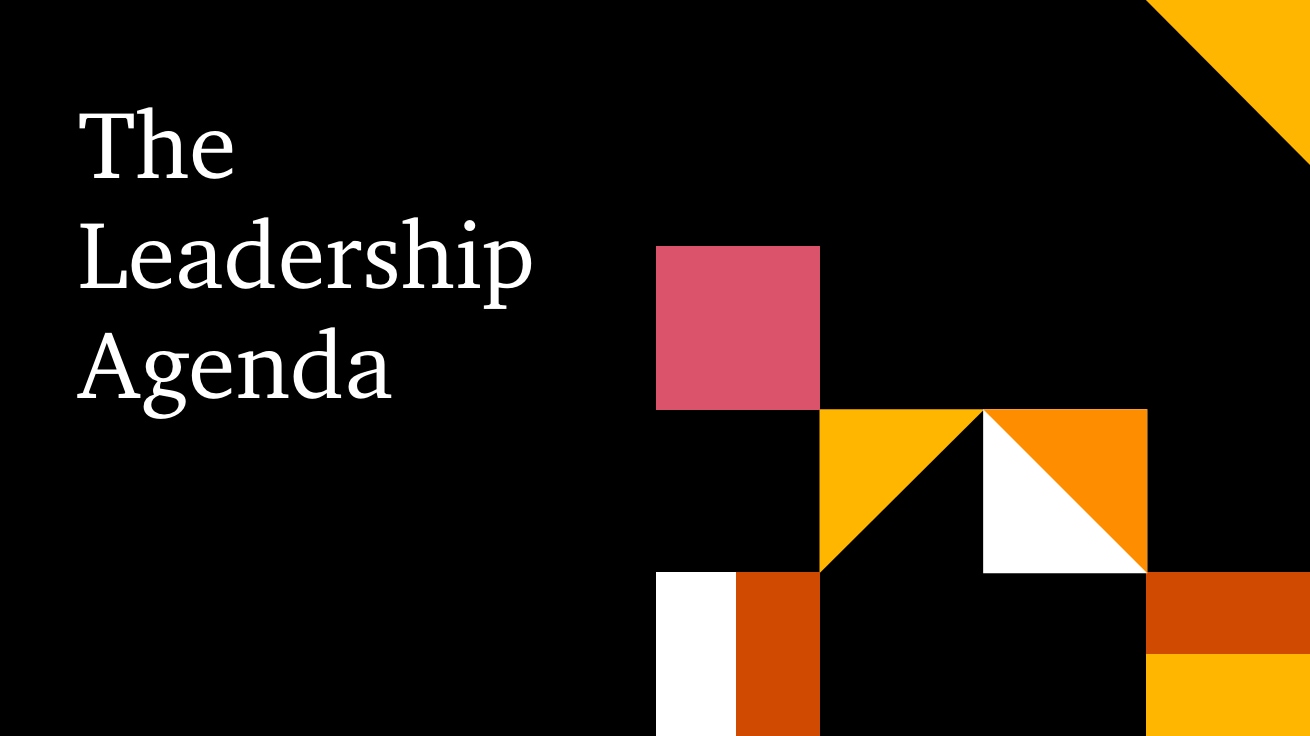Take on
Tomorrow
This special series of Take on Tomorrow explores PwC’s value in motion research, unpacking how the global economy will change over the decade ahead and what that means for business and society. We’ll delve into how business will navigate—and shape—the challenges and opportunities ahead, including emerging technology, climate impacts, and new ways of collaborating across industries.
Along the way, we’ll meet the innovators driving the efforts to tackle society’s greatest challenges and learn how businesses can capture the value that’s in motion and the exponential possibilities that come with it.
Listen and subscribe now on your favourite platform
How can AI scale our capabilities at work?
Have you noticed something different about customer service calls lately? Maybe even something...delightful? Perhaps the service rep not only anticipated your question but had the perfect suggestion? That could be AI working behind the scenes, supporting those call center employees and making life a little smoother for you. It’s just one way technology is shaping our everyday lives and changing how businesses serve customers—and interact with their workforce. All this change is happening at breakneck speed—so how can businesses get ready for a new kind of connection with customers and the world? And how might those connections create new ways of working—and new kinds of value?
To find out, our hosts Femi Oke and Lizzie O’Leary are joined by Kris Narayanan, Chief Digital Officer at Verizon Business. Then, Matt Wood, PwC’s Global and US Commercial Technology and Innovation Officer, tells us what leaders need to do to drive the AI revolution in a time of technological and cultural change.
Listen and subscribe now on your favourite platform
KRIS NARAYANAN: A rep for sure is not going to remember what they said to you last year. But now AI-enabled reps can actually remember what was proposed to you last year that you may have accepted or rejected so that they can personalize what’s presented to you.
MATT WOOD: The number one question that I find myself asking over and over again is just, Have you tried it? This to me is the most powerful AI question of 2025 and, maybe, 2026.
KRIS: Your ability to infer context and understand what’s on the customer’s mind improves drastically. But what’s also improved drastically is your relevance to that customer, because youre retaining context for a lot longer. What generative AI does is put that on steroids.
FEMI OKE: Think back to the last time you had to talk to customer services. Were they able to anticipate what you need? Help you quickly, with a perfect answer?
LIZZIE O’LEARY: Well, if it feels like that automated process is improving, you’re not imagining things. AI now allows customer service employees to make life a little smoother for you.
FEMI: And that’s just one way current technology is changing our everyday lives, impacting how businesses serve customers—and how they interact with their workforce. But it’s really just the beginning.
LIZZIE: And with all this change happening at breakneck speed, how can businesses be ready?
FEMI: I’m Femi Oke, a broadcaster and journalist.
LIZZIE: And I’m Lizzie O’Leary, a podcaster and journalist. And this is Take on Tomorrow, the podcast from PwC’s management publication, strategy and business.
FEMI: Today, how will AI change the way you do business?
LIZZIE: Later today, we’re going to hear about how GenAI is changing customer service, with Verizon’s chief digital officer.
FEMI: But before that, to help us understand what’s possible with this technology— and what sets apart the companies already using AI—we’re delighted to be joined by Matt Wood, PwC’s global and US commercial technology and innovation officer. Hello, Matt.
MATT: Hi, thanks for having me.
FEMI: Matt, I can imagine that you live, work, and breathe AI literally all of the time. Tell us, how do you use AI tools during your day? Is it just in your work?
MATT: Honestly, pretty much anything that I am doing today, I’m using AI. I actually have two computers. So I have the computer I’m recording this podcast on, and I have a second computer right next to me that I do all my engineering work on. That’s usually prototyping new ideas, trying out early prototypes for hard AI-driven problems that we want to solve inside PWC. And as I'm talking, I almost always have two or three engineering agents running for me: writing code, trying out ideas, coming back with responses, asking me questions and clarifying questions, forming a specification of the type of work we want to do, helping me brainstorm new ideas. And so at any time, I probably have, I would say, five or six agents interacting with me in pretty much everything that I do. And over the course of a day, I would say there’s probably 20 different agents that I interact with, doing all these different tasks, that help me amplify what I’m already doing. I think that’s a kind of a critical turn in the road that we have made in probably the last year.
LIZZIE: Matt, listening to you, it’s very clear that you’re incredibly passionate about this. I wonder, what makes you the most excited about this tech right now?
MATT: It’s as much about the opportunity as about what it can do today. I think what AI can do today is pretty remarkable. But for me what’s really exciting about AI is that it is unusually horizontal. Most technologies, when you take a look at them, when they first kind of appear, it’s easy to see them as being very, very broad, and you imagine all the possibilities that it could be used in. But over time, as you start to understand what it’s really good at, you start to kind of fit it inside a much smaller number of discrete boxes. But with AI, the opposite is happening. The more that AI progresses, the better that it gets. The more we understand this remarkable discovery, we’re able to find newer and newer and broader and broader ways of applying that discovery. And so, it’s going to change almost every aspect of how we work, how we communicate, how we analyze, how we write, how we create, going forwards. So for me, that’s what makes this most exciting.
LIZZIE: Matt, thank you so much. We’re going to come back to you very shortly to hear more about what business leaders can do to drive AI adoption.
FEMI: But before we do that, can you imagine talking to a customer, or an employee, and you could remember every single word of a conversation you had a year ago, and use that to help them solve the problem they’re having today.
LIZZIE: It’s easier than you think, thanks to new AI tools. To learn more, I spoke to Kris Narayanan, Verizon's chief digital officer. We began by looking back at how digital technology has changed the world of work.
KRIS: If you just went back, let’s say 30 years or so, this age of the internet began with the desire to digitise virtually everything—the way we shop, the way we buy, the way we consume media, as consumers. But in a corporate setting, you think about digitizing business models, digitizing process, digitizing workflows, AI has always been underpinning of this and mainly from how we use predictive and descriptive technologies to improve the way we make decisions, to improve our understanding of what our customers are doing or of what’s happening in the market. And that’s, of course, getting turbocharged with generative AI. And then the push to automate, which you know has arisen more recently, but was always there to a degree, the push to hyperpersonalize, which we’re starting to talk about,—personalization, but much more real time, much more context aware. It’s a very exciting amount of change when you think back.
LIZZIE: Chris, in your position as chief digital officer, you have seen a lot of technological change. Where is GenAI having the most impact on what you and your teams do day-to-day?
KRIS: So, it’s shifting as we speak, right? I’m sure literally in this week or this hour, we’re going to see new capabilities launch. So it’s—a lot of these decisions, even if the data is near real time, lack context because not a lot of the pieces are always connected to one another. So think about, for example, data from the web, data from a call center, data from a vehicle, data from an app that you’ve been using. These were generally all collected, all used, and potentially leveraged for personalization within those contexts. Now, doing that in real time, allows you to realize a lot of benefit in context understanding. But what generative AI does is put that on steroids. Your ability to infer context and understand what’s on the customer’s mind improves drastically. But what’s also improved drastically is your relevance to that customer, because you’re retaining context for a lot longer. My conversation I had with you last year is in present memory, so that allows me far greater depth of enrichment of what I say to you, what I offer to you, based on the context. That is completely radical. Because even a corner store manager may only remember a little bit about what happened last year. A rep for sure is not going to remember what they said to you last year. But now AI-enabled reps can actually remember what was proposed to you last year that you may have accepted or rejected, and then to understand what happened to you yesterday or even this morning so that they can personalize what’s presented to you. So to me, context, availability, enrichment, and memory is the richest and perhaps most, like, interesting part of this. That’s what GenAI does to sort of super-speed, or amplify, everything else that’s happened in the last 30 or 40 years in digitization.
LIZZIE: And customers must see a lot of this change firsthand. So, what are customer reps able to do now that they wouldn’t have been able to without the use of these AI tools?
KRIS: Yeah. There are plenty of ways already. For one, if you don’t let a lot of very simple things surface to them, things that an IVR [interactive voice response] could answer or AI can answer, reps are left to answer slightly more complex things that potentially automation cannot address. So there alone, reps are able to add value through their empathy, their understanding, and their ability to deal with more complex queries and customer situations versus “Can you tell me the balance on my account?” But now, if you start enriching the customer and the rep’s conversation—be it sales or service—with the help of context understanding, you have a better, richer, more current understanding of what the customer is going to say before they even say it. The rep’s ability to serve customers'’ needs in real time, so long as they know how to use AI tech that is in front of them, is going to vastly improve their relevance and their ability to serve needs and hopefully satisfy their customers.
LIZZIE: And have you seen an impact on the customers you serve? Are they happier customers?
KRIS: Customers’ expectations change constantly. I remember writing a slide back in 2010 that no matter where you do a search on the web, you expect it to work as good or better than Google. When you want to interact with a person, you expect it to work as seamlessly as Facebook. When you want to order a service, you expect it to be as instant as Uber, right? So those expectations get translated to all of the things that Verizon provides to you as a customer. Now, guess what. We may not be equipped to be the best of Google and the best of Amazon. That’s virtually impossible. But that’s what technology allows us to do. It allows us to carefully figure out how to equip our frontline people to position our “val props” and to create the automations and capabilities in the back that allow us to scale our ability to serve customers. We’ve improved a lot in the last ten years. And we’ve improved a lot in the last year. But trust me, [it] pales in comparison to how much we’ll have to change and improve in the next year or three.
LIZZIE: This conversation has really been about the opportunities these new technologies present. So what should businesses stop doing—and start doing—now to be ready for this AI future?
KRIS: I wish that decisions on how to adopt and use technologies were simple, but they’re not. They’re complex, they’re nuanced. And particularly with things like GenAI, they're also deeply impactful, both positive and potentially in a negative way, if you—depending on how broadly you see it. So I think what companies ought to do is have very deep and informed conversations, dialogues, within the company, with experts that help them, the partners that can assist, and certainly with their customers and partners and the folks outside, so that what you’re informed by and directed by is the best of what the world has to offer. So that’s part one. I would say also, part two: Data is what really makes all of this happen. And our ability as companies to bring that together and make sense of it, to unify it, is the key to unlocking the value that sits in it and our ability to act in an agile fashion to adopt and use generative AI. Third is the ability to take carefully thought through bets. If you wait too long and are too careful on these bets, then you’ve waited too long and you’ve missed the train, right? So you have to have the ability to use the technologies and test your business capabilities, if not your business models, in near real time. And that’s where your partners can help you, because they provide the learning, but sometimes also the safe spaces where you can potentially test your business models and hopefully test the ways in which you impact your employees and customers positively.
LIZZIE: And this one is a question that we ask all of our guests. So, if you look forward a decade, how might the way we work look completely different compared to now?
KRIS: Yeah, look, I can scarcely imagine what it looks like a year or three from now, let alone how it could look a decade from now. The underlying things that I know are harder to truly replicate are deep, rich human understanding. I think technology is able to emulate it, but not replace it. And there’s a lot of thoughts about AGI [artificial general intelligence] and how that’s going to basically have virtually human levels of emoting and emulation. But barring that, I think that as humans, we still should be facing one another to solve hopefully human problems that I’m sure will exist at many levels ten years from now, with massive help from technology t’s very hard to imagine today. So that’s sort of angle one. Angle two, I would say is even though we’re teaching technology to be creative, technology I don’t think is still as good at being creative as humans are. And I believe that is still the domain of humans ten years from now, with a huge dose of assistance from technology. So, I believe that when you translate these to the workplace, what it demands [is] that people that are far more adept at using technology on a far grander scale so that they can focus their energies on human understanding and serving human needs in far more real time.
LIZZIE: Kris, thank you so much.
KRIS: Thank you for the time.
FEMI: Matt, we heard from Kris about the way that this technology could really drive human creativity, so I wanted to ask about the role leaders play in getting to that point. How do they drive AI adoption within an organization?
MATT: I think this is probably in the top two or three questions that most senior leaders have on their to-do list. There is no magic bullet. I think the first thing is to kind of acknowledge that inside most organizations, you have actually a pretty broad distribution of different levels of interest and willingness to adopt change. On one end of that bell curve, you have a relatively small number of what you could consider innovators. This is a group of people inside your organization. They are really excited for the technology. They don’t need your permission to go learn about these things. They don’t need your training schemes. They are perfectly happy to spend their own time and cycles ’cause they’re naturally drawn to the opportunity. Behind them, you actually usually havea slightly larger percentage of another population who are, kind of, the early adopters. They’re a little bit more resistant to failure. Then behind them, you have the late adopters. They don’t really care one way or the other. They just want to get their work done. They’re not pro, they’re not anti. They'll just use what is on the path of least resistance to get their work done. And then at the tail end, you have what are sometimes kindly or unkindly called the laggards. These are people who will just actively resist any change, because they’ve just been doing this the same way probably for 20 years. And change for them is much more difficult, and is much more risky, and is a much higher lift for them than the rest of the organization. And understanding that you have this sort of bifurcation of innovators and early adopters and late adopters and laggards can really, really help you when you’re dealing with AI adoption. Because the type of things that you ask that first category, the innovators and the early adopters, the messaging that you give to that group is very different from the messaging that you give to the late adopters and the laggards.
LIZZIE: Matt, when you look at how AI is being rolled out among and between companies, are there any kinds of innovative partnerships you have seen develop between companies because of AI?
MATT: Yeah, for sure. So, with artificial intelligence, you are taking expertise and skills, reasoning, intelligence, capabilities that were once very, very rare, and making them, you know, broadly democratized. And the result of that is that a lot more people have access to a lot more expertise, a lot more skills, and a lot more intelligence than they had before. And the second order effect of that is that the hard boundaries that exist between subsectors, sectors, and industries, they really start to blur. And that can happen between industries. So you may see organizations that are best known for very planetary, terrestrial work. Things like farming and agriculture start to become much more invested in extraterrestrial work, like space and computer vision using satellites. And the blurring starts to happen between the industries that work close to one another as well. And so those that maybe were involved in HVAC for individual buildings, they may start to get more and more interested in real estate itself. Those that were interested in real estate may get more and more interested in power generation. And so, no matter where you kind of put your pin in the landscape of enterprise, those edges of the territories are really, really starting to blur.
LIZZIE: You know, we’re talking about some really big realignments here and some questions that come up are, how should organizations rethink performance benchmarks when we’re talking about an AI-enabled workplace? And are there narratives that work better than the sort of human versus AI comparisons when you are introducing these tools?
MATT: Yeah, I think human versus AI is not usually a very fruitful way of positioning these things. A much more useful approach is to say, “Hey, look, these things exist. This is where they’re useful. We have done the work to validate them, to verify them. These are the guardrails we put around them. This is what you should do, this is what you shouldn’t use.” And then be really, really empathetic that this is a human level change. In almost all cases today, we could have AI systems that were indistinguishable from perfect in the responses that they generated, and we could do those perfect responses at effectively zero cost, and most organizations would still be slow to adopt, because the process of adoption is a very human one. You are really asking people to change how they work. You are asking them to learn an intimidating new approach. You are asking them to do so in real time as the technology is being built out under you. And that is a very, very challenging human problem.
LIZZIE: When you are talking to clients or even colleagues at PWC, what do you find slows down change and AI adoption from really taking hold?
MATT: The number one question that I find myself asking over and over again is just, “Have you tried it?” This to me is, like, the most powerful AI question of 2025 and maybe 2026. A lot of teams are—they have an idea of what they could use AI to do, and there’s also almost an infinitely long list of reasons not to do it. But if you try it, how far do you get? And usually when that team go back and they just try it, usually the AI systems are a lot more capable than they were expecting, and they do a lot better job than they were expecting. And that really helps the teams define what that final 50% looks like. No longer is it an ambiguously infinitely long list of reasons not to do it, that they don’t have; all of a sudden, they’ve got a checklist of things that they just need to go get. And so just try it.
FEMI: I am going to turn you into, Matt, a human listicle. You know those articles that you see—you’ve probably even written one or two—common mistakes you see companies make right now in the AI era.
MATT: Yeah, I’ll give it a try. Number one, an assumed failure, like just assuming that the thing won’t work. Number two, accepting the first answer from an AI system. You know, that’s kind of legacy thinking, honestly. Just generate a hundred, and see which one you like the best. And then, I think, the third one is locking into a strategy too soon. So you’ve really got to keep your, kind of, head on a pivot and stay as elastic as possible.
LIZZIE: Well, then the, what’s the flip side of that? What are some, you know, examples of companies that are making real gains with AI right now and the secrets to their success?
MATT: Yeah. I mean the opposite of all those things, it is maximizing the learning rate. It is trying early, being tolerant to those early failures. Experimentation is just like that, like where there’s a—there’s the old adage of WD-40, the thing you put on your bike chain to stop it rusting, that’s called WD-40 because it was the 40th iteration of the chemical formula for that substance. They had 39 failures before they hit on WD-40. It was the 40th one. And I think that’s totally OK. That you should expect a high degree of failure. Throw as much as you can, optimize for information rate and learning rate, and be tolerant to failures.
FEMI: Matt, how long have you been working in the AI field?
MATT: Oh, that’s a good question. I would say nearly 30 years.
FEMI: All right, so this next answer should be brilliant, because I’m only going to ask you about what you anticipate will happen in the next ten years.
MATT: It is going to be a completely different way in which we interact with data, with information, and with each other. It’s kind of hard to think of any role that exists today that won’t be materially different in ten years. And over the next ten years, the majority of AI use, probably by an order of magnitude, if not more, will be through AI systems interacting with other AI systems. They’re going to be working together; they’re going to be combining their knowledge; and they’re going to be running 24/7 in order to be able to drive the sort of day-to-day operations that today require a huge amount of cognitive work by humans. And AIs will be able to do that and be able to talk to each other to do that way more efficiently than people. And that innate humanness is going to be focused on working with each other and with AI systems to brainstorm, to understand, to be curious, to be able to invent, to be able to build in ways and with efficiency in and with inventions that just don’t exist today. And I think we are really on the precipice of a remarkable golden era of human connectivity, a remarkable golden era of invention—driven in part because we’re offloading a lot of the day-to-day operations to AI systems that are going todo it better than us. And that reserves so much more time and effort for the act of creativity and the pursuit of curiosity.
FEMI: Matt, thank you so much for joining us.
MATT: My pleasure. Thank you.
LIZZIE: That was a fascinating interview for me, Femi, because I feel like what we were starting to hear from Matt and from Kris were ways of thinking about AI that maybe are not the binary human versus AI that I feel like isn’t in common conversation, but really about new ways of working, thinking, complementing somebody’s workday, complementing what they’re doing while they are doing other things.And that I think is new to me.
FEMI: And as I’m thinking about Kris and Matt’s conversation, it really helps me understand our entire series, which is, with technology we can go deeper, ask for more, and get so much more.
LIZZIE: Because I think each guest who we’ve talked to is hinting at something deeper in each conversation. It is about larger and more fundamental transformation, and then the things that follow on from that—how that ripples out across communities, where that falls unevenly, and how those transformations take place. And you’re right, this is something that feels much bigger than just the current moment.
LIZZIE: That’s it for this episode and this special series of Take on Tomorrow. If you want to be sure that you never miss an episode, then follow the show wherever you listen. And for more visit pwc.com/takeontomorrow.
COPYRIGHT MESSAGE
FEMI: Take on Tomorrow is brought to you by PwC’s strategy and business. PwC refers to the PwC network and/or one or more of its member firms, each of which is a separate legal entity.
Hosts

Lizzie O’Leary
Podcaster and journalist

Femi Oke
Podcaster and journalist
Guests

Matt Wood
Global and US Commercial Technology & Innovation Officer, PwC US

Kris Narayanan
Chief Digital Officer, Verizon Business
All episodes in the series

The strategy+business digital issue
In-depth analysis, quick-hit summaries, interactive data, and visual storytelling to inform and inspire the C-suite.

The Leadership Agenda
Sharp, actionable insights curated to help global leaders build trust and deliver sustained outcomes.
Value in motion
AI, climate change and geopolitical shifts are reconfiguring the global economy. We’ve mapped where value is moving over the next decade, so you can build a future-ready business to capture it.
The Leadership Agenda
Sharp, actionable insights curated to help global leaders build trust and deliver sustained outcomes.
Contact us

© 2017 - 2025 PwC. All rights reserved. PwC refers to the PwC network and/or one or more of its member firms, each of which is a separate legal entity. Please see www.pwc.com/structure for further details. This content is for general information purposes only, and should not be used as a substitute for consultation with professional advisors.











